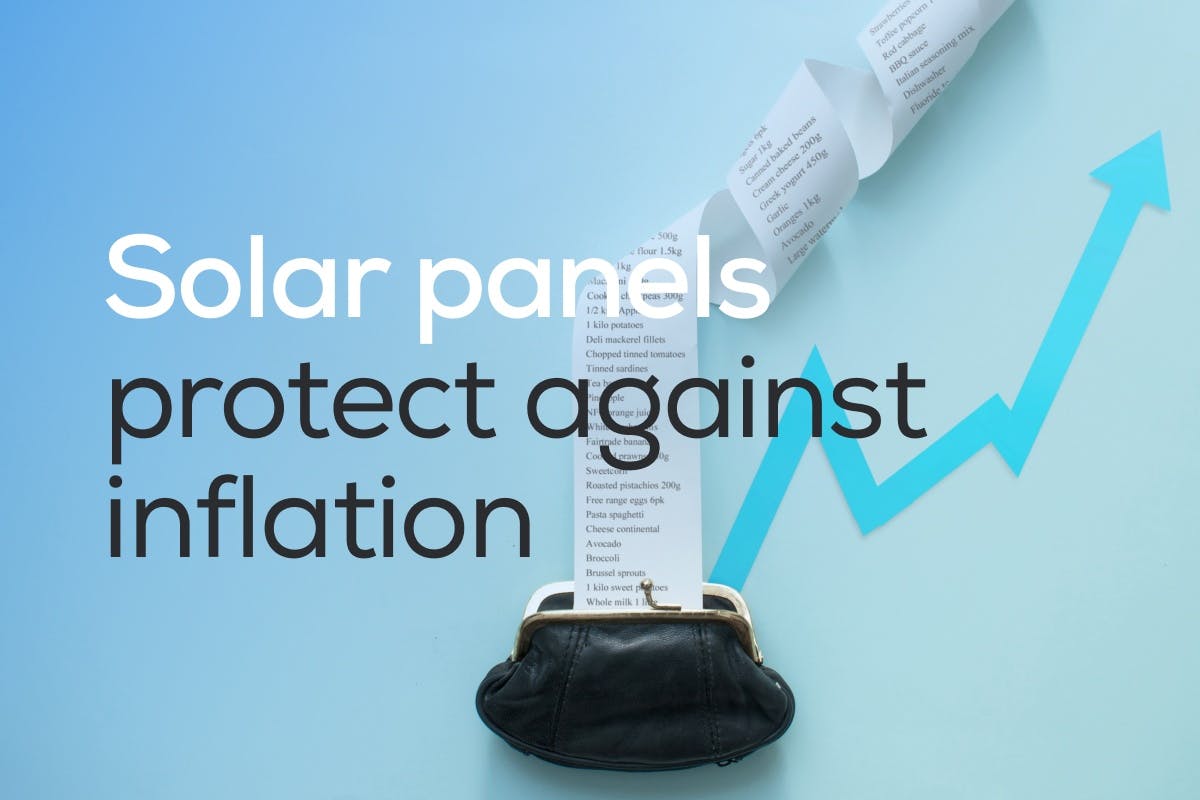Can Solar Panels Protect Against Inflation?
Last edited

Author
Cory O'Brien
Senior Director - Growth Marketing

Editor
Ryan Barnett
SVP, Policy & New Market Development

Research shows that retail prices for electricity have increased for decades, often faster than the rate of inflation. Current industry projections predict that those prices will continue to climb. Thankfully, one of the best ways to protect against inflated energy costs is by investing in solar panels.
When you create your own electricity with a solar power system, you don't have to draw as much from the utility grid, which can help you avoid those rising prices. In fact, going solar means you can lock in a specific price per watt (PPW) that won’t change for the life of your system. This guide will explain how investing in solar panels is an investment strategy that can help you avoid inflation in one area of your life, and save money in the long term.
See how much you can save by going solar with Palmetto
A Short History of Energy Prices
The Energy Information Administration (EIA) has collected data on United States electricity prices dating back to 1960, and the evidence clearly shows that electricity prices have trended upward over time, and that trend is not likely to change anytime soon.
Here are the average retail prices of electricity in cents per kilowatt-hour (kWh) over the last 60 years:
- 1960: 2.6 cents per kWh
- 1965: 2.4 cents per kWh
- 1970: 2.2 cents per kWh
- 1975: 3.5 cents per kWh
- 1980: 5.4 cents per kWh
- 1985: 7.39 cents per kWh
- 1990: 7.83 cents per kWh
- 1995: 8.40 cents per kWh
- 2000: 8.24 cents per kWh
- 2005: 9.45 cents per kWh
- 2010: 11.54 cents per kWh
- 2015: 12.65 cents per kWh
- 2020: 13.15 cents per kWh
Since solar power systems are expected to last for 25 years or longer, just imagine the cost of electricity that your system will be offsetting as it gets older.
These rising prices are amplified by increasing instability in the electrical grid. In 2022, as inflation surged across the country and supply chain issues caused financial chaos, electricity prices jumped 15.8% in a single year, and that increase was compounded by soaring temperatures that kept air conditioners working overtime.
As a result, the National Energy Assistance Directors Association (NEADA) estimated that the average family's cooling costs rose from $450 in 2021 to about $600 in 2022. Homeowners can end up getting gouged on their electricity bills through no fault of their own, so why not avoid that price insecurity with solar panels?
A Short History of Inflation
Historically, inflation has hovered around 2% each year, although inflation spiked in 2022, with prices rising more than 8% in that inflationary environment. The Bureau of Labor Statistics keeps track of inflation data, and has a breakdown of what the past decade has looked like:
- 2012: 2.1%
- 2013: 1.5%
- 2014: 1.6%
- 2015: 0.1%
- 2016: 1.3%
- 2017: 2.1%
- 2018: 2.4%
- 2019: 1.8%
- 2020: 1.2%
- 2021: 4.7%
- 2022: 8.3% (Estimated)
As you can see, everything (including energy from power plants) gets steadily more expensive over time, making the purchasing power of a dollar less and less as time goes on.
A Short History of Solar Energy Prices
A decade ago, it was fairly expensive to have solar panels installed on your home. However, the cost of solar has actually gone down significantly in recent years, which means many more people now have the financial capability to invest in a solar energy system.
Instead of getting more expensive each year with inflation, solar is actually getting more affordable, going against the trend. (There’s a reason clean energy was such a big part of the Inflation Reduction Act of 2022!)
In addition, once you go solar, the cost of the electricity those panels create is a fixed rate, so there’s no increase in cost over time.
Here is a breakdown of the average cost per watt for a 22-panel residential system since 2010, according to a study of the solar industry by the National Renewable Energy Laboratory (NREL):
- 2010: $7.53/watt
- 2011: $6.62/watt
- 2012: $4.67/watt
- 2013: $4.09/watt
- 2014: $3.60/watt
- 2015: $3.36/watt
- 2016: $3.16/watt
- 2017: $2.94/watt
- 2018: $2.78/watt
- 2019: $2.77/watt
- 2020: $2.71/watt
The overall cost of installing a solar system is the lowest it has ever been. Ten years ago, you would have spent an average of $50,000 on a standard six-kilowatt-hour residential solar system. That same highly efficient system today could cost you between $16,000 and $21,000 on average.
See how much you can save by going solar with Palmetto
How to Protect Against Inflation With Solar Panels
As electricity rates continue to rise, you can help protect your money by investing in solar panels. If your solar panels produce enough electricity to power your home, you no longer have to rely on the electrical grid as your main source of power. This also means that the money you previously spent on your electricity bills can now be invested in your home, or used to pay for other things that are getting more expensive as a result of inflation.
Solar Panel Payback Period
For the first few years after installing your solar panels, any savings you see typically goes toward paying off your solar panel system. Also known as your solar panel payback period, this is the amount of time it takes for your electric bill savings to equal what you paid for your solar system.
Here is a very high-level example:
- $20,000 total cost of your solar panel system - $6,000 in Residential Clean Energy Credit (30% investment tax credit, if eligible) = $14,000 investment
- $145 average monthly bill savings x 12 months in 1 year = $1,740 in annual savings
- $14,000 ÷ $1,740 ≈ 8-year solar panel payback period
While you could use the money you save with solar panels for other purchases prior to paying off your solar panel system, you could see higher savings overall by using those savings to pay off your system sooner, since you won’t be paying any additional money towards financing.
Assessing Your Solar Panel Savings
Once you complete your solar panel payback period, the money you save from your solar panels is money back in your pocket, instead of money that goes in the pocket of your utility. It’s also important to recognize that your payback period could become shorter as electricity rates increase due to inflation. The more money you save by not using electricity from the utility grid, the quicker you could see net savings from your solar panel system.
Even better, you should continue to save even more money from the electrical production of your solar panels as energy rates continue to rise. If you’re able to get most of your power from your solar panels, you don't have to worry about an unexpected increase in out-of-pocket costs. Thus, investing in solar panels provides peace of mind from worrying about whether you can afford rising electricity costs at a later date.
If your solar panels generate more electricity than your home can use, you may also be eligible for net metering. In a net metering setup, when you send any excess electricity generation to the utility grid, the utility company will issue you a credit on your bill for the amount of electricity you contribute that can be used to offset future electricity expenses.
As you consider investing in a solar panel system, check your area to see if they offer net metering, as not every state and/or utility provider does.
Use Solar Savings as a Hedge Against Inflation
When you combine the various ways you could save money with your solar panels, it can help soften the blow of inflation in other areas of your life.
Reducing Your Mortgage
Depending upon the type of mortgage you have on your home, your solar savings can go a long way in combating any rate increase you might see. If you lower your energy payments with a solar panel system, you may choose to apply that money toward paying off your mortgage faster, saving you even more money in the long run.
Food
Groceries typically get hit by inflation in significant ways. Instead of spending money on energy bills, you can use those savings to stock up on food necessities. This also includes stocking up on frozen items you can store in a freezer that’s now powered by affordable electricity from your solar panels.
Furniture
Other household items highly impacted by inflation include furniture and bedding. With your solar savings, you could invest in that new couch and bedding set you have been eyeing, and not feel bad about it. Upgrading to higher-quality items can help improve your overall quality of life, and they’ll often last longer than inexpensive products, too.
Entertainment Money
When you look at your monthly finances, “fun” money is often reserved for whatever you have left over at the end of the month, after you’ve paid all the major bills. Since you are likely spending less money on electricity with solar panels, you ought to have more money left over each month to spend on activities like the movies or a vacation.
New Car
The savings you create by having solar panels can help speed up the process of saving for a new car. Used car prices are up from before the pandemic, and new cars are seeing a price hike as well, so the extra cash can help with affording a new car purchase.
How To Protect Against Inflation With Solar Panels
The cost of electricity has been rising steadily over time, but you could avoid those increases by investing in solar panels. Since the cost of installing a solar panel system has decreased over the last decade, solar has become one of the best investments to protect against inflation, with a return on investment that just continues to get better over time.
Once you have made it through your solar panel payback period, you’ll be saving money each month from your solar panels. You could then take that extra money and use it to combat inflation in other areas of life, such as:
- Loan Interest
- Food
- Household Furniture
- Entertainment
- Cars
If you're ready to avoid rising energy prices by installing solar panels, get started today with Palmetto. You can use our Free Solar Design and Savings Estimate Tool to see how much you could save by going solar, and get a preview of what solar panels would look like on your home’s roof.


